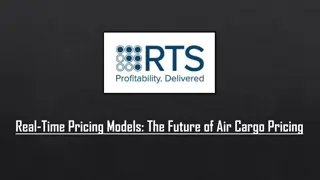Inefficiency of Risk Pricing in Public-Private Partnerships
This discussion focuses on the inefficiency of risk pricing in Public-Private Partnerships (PPPs) and the implications for taxpayers. The analysis covers why PPP risk pricing is a critical topic, the costs of transferring risks to private parties, when risk pricing is considered efficient, and the role of risk pricing in decision-making under uncertainty. It emphasizes the need for efficient risk pricing mechanisms in infrastructure projects to ensure value for money and optimal allocation of risks between public and private sectors.
Download Presentation

Please find below an Image/Link to download the presentation.
The content on the website is provided AS IS for your information and personal use only. It may not be sold, licensed, or shared on other websites without obtaining consent from the author. Download presentation by click this link. If you encounter any issues during the download, it is possible that the publisher has removed the file from their server.
E N D
Presentation Transcript
Inefficiency of Risk Pricing in Public-Private Partnerships Paris, June 2016 Dejan Makov ek, Economist/OECD-ITF Marian Moszoro, Berkeley-Haas/US
Why discuss PPP risk pricing Countries seek infrastructure to boost their growth Political perception that private finance can help closing infrastructure gap (G20, WEF...) Private investment assessed on (unsatisfactory) framework: Value for Money of PPPs vs. alternatives Unclear cost that state pays for transferring risk to private party
Cost of risk transfer from public to private How much taxpayer has to pay to transfer risk to a private party? Currently accepted propositions: Differential public/private financing cost is apparent Private sector expresses risks explicitly (ex-ante) Public sector (taxpayer) bears risk implicitly (cost over- runs ex-post) Propositions true only if risk pricing efficient
4 When is the price of risk efficient (1) Conventional financial economics says that is when: There is competition between suppliers Investors are rational Capital markets are complete Investors use all available information Efficient Markets Hypothesis (EMH) holds
5 When is the price of risk efficient (2) High returns Return/Risk High losses t EMH assumes that all uncertainty will eventually dissolve in objective probabilities Uncertainty Risk
7 Risk pricing and the tax payer Decision making under uncertainty Diversifiable risk State has no advantage Systematic risk Not relevant (state can do better) CAPM (tool) EMH Welfare economics (view/principles) (view/principles)
8 Is risk pricing efficient analysis design (1) Subject of analysis: Market of capitally intensive project- finance PPPs Testing for EMH not possible No security/price data (EMH not met by this fact alone; already known) But this would not capture the risk pricing efficiency holistically SPV
9 Is risk pricing efficient analysis design (2) Alternative Can we get a view on the extent of inefficiency? 1. What is the availability of risk-related information (uncertainty)? 2. Is there direct evidence of above average returns? 3. When abnormal returns cannot be assessed directly, is there evidence of improper risk assessment/systematic errors? (Demand risk, construction risk) 4. How does risk transfer (to a PPP) affect competition?
10 Evidence review (1) What is the availability of risk related information (uncertainty)? Good in lending Poor/informed guessing at many levels (investors, traffic forecasting, construction cost estimation, no data on operation performance) Is there direct evidence of above average returns? Several UK case studies IRR s were much higher ex-post than those agreed at financial close
11 The evidence review (2) Is there indirect evidence of systematic errors? Demand risk: Presence of systematic demand shortfalls in PPP toll projects on average Interpretation: Dumb money / winners curse ? (difficult to accept persistence) Alternatives? (strategic behavior)
12 The evidence review (3) Is there indirect evidence of systematic errors? Construction risk: risk premium in roads above ex-post risk (+20% in EU; +60% in the US), LCC does not explain diff.) Unexplained cost difference Traditional procurement Cost at contract signature Cost overrun Public-Private Partnership Total cost Risk transfer impact on affect comp. for the contract? Negative/self-selection (few studies).
The emerging image of risk pricing efficiency in a PPP Public entity PPP contract risk shedding/ diversification a premium in the form of excess returns Lenders, investors SPE Suppliers (risk transfer) a premium in the form of higher base cost (e.g. capex) Subcontractor
14 Conclusions (1) The private sector faces (in PPPs) : Lack of information/uncertainty challenge Lack of diversification opportunities in private sector Compounding issue large risk transfer can reduce competition.
15 Conclusions (2) The state has several inherent advantages: It can approach the lack of information problem with risk neutrality Two reasons for risk neutrality: Arrow and Lind 1970 risk spreading theorem State can pay for risk if and when it materializes with no extra cost above the risk itself It can diversify over all taxpayers
16 Conclusions (3) Current work and further recommendations: Infrastructure as an asset class (solves only the SPV level of the problem) already underway Closer look at state/SPV risk allocation (risk, uncertainty, manageability) Closer look at PPP alternatives (regulated model), in particular when no continuous competitive pressure is present (rail/road)
Thank you! dejan.makovsek@itf-oecd.org mmoszoro@berkeley.edu

 undefined
undefined








































